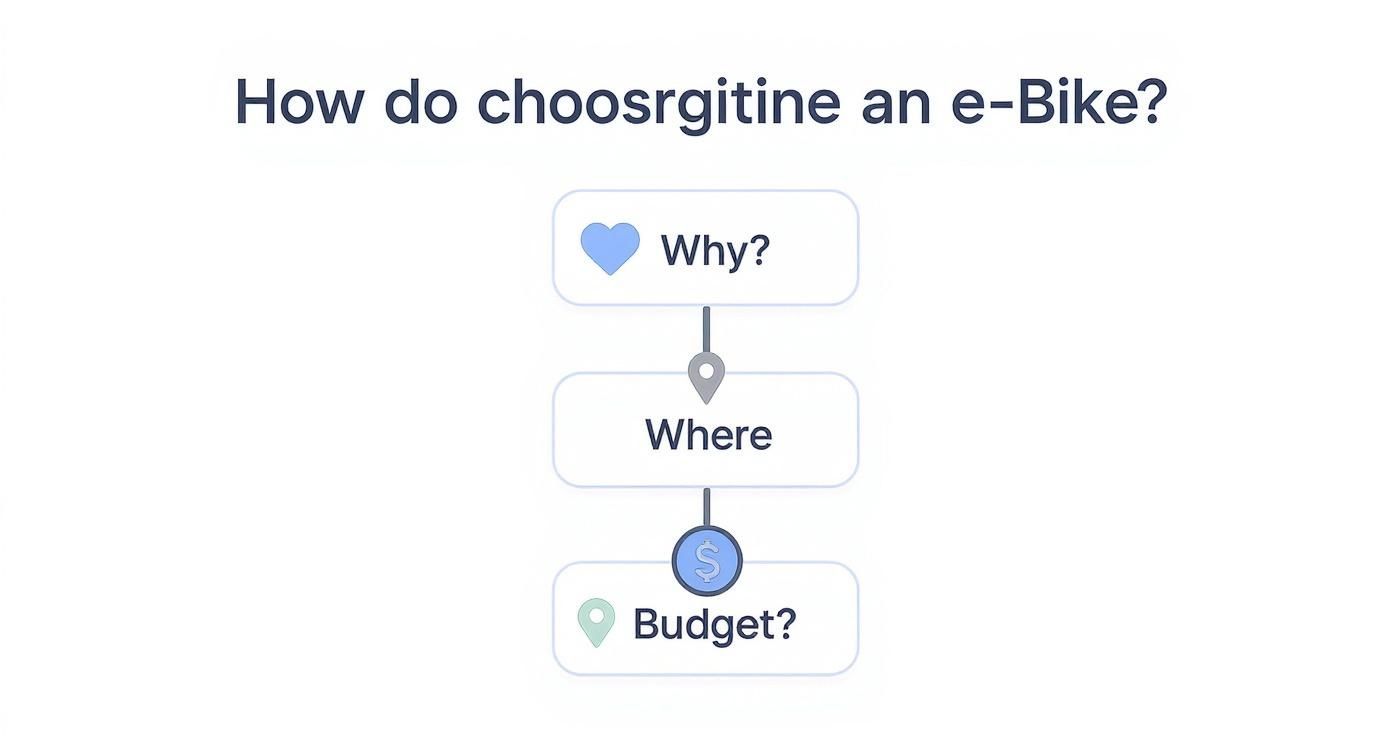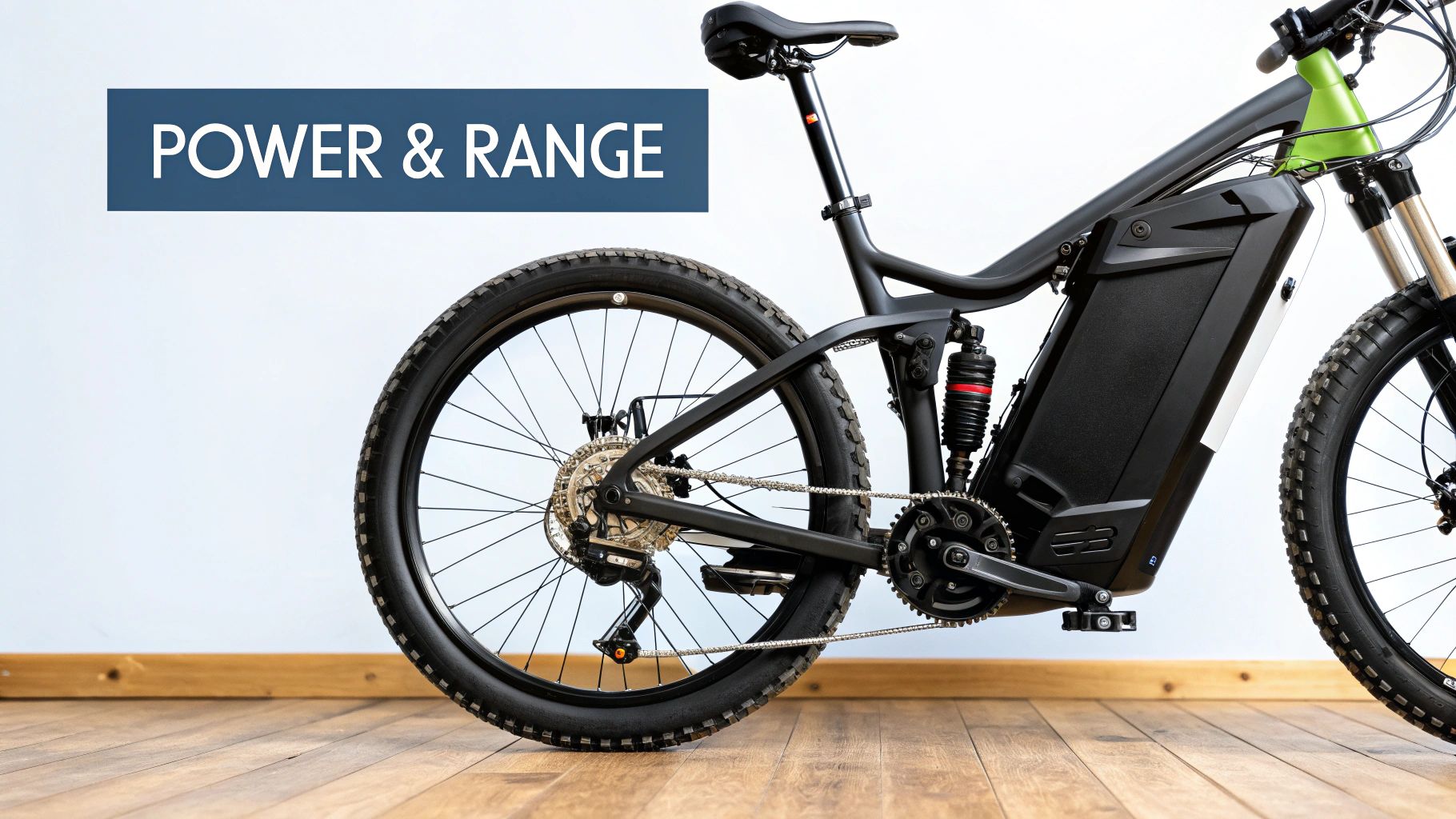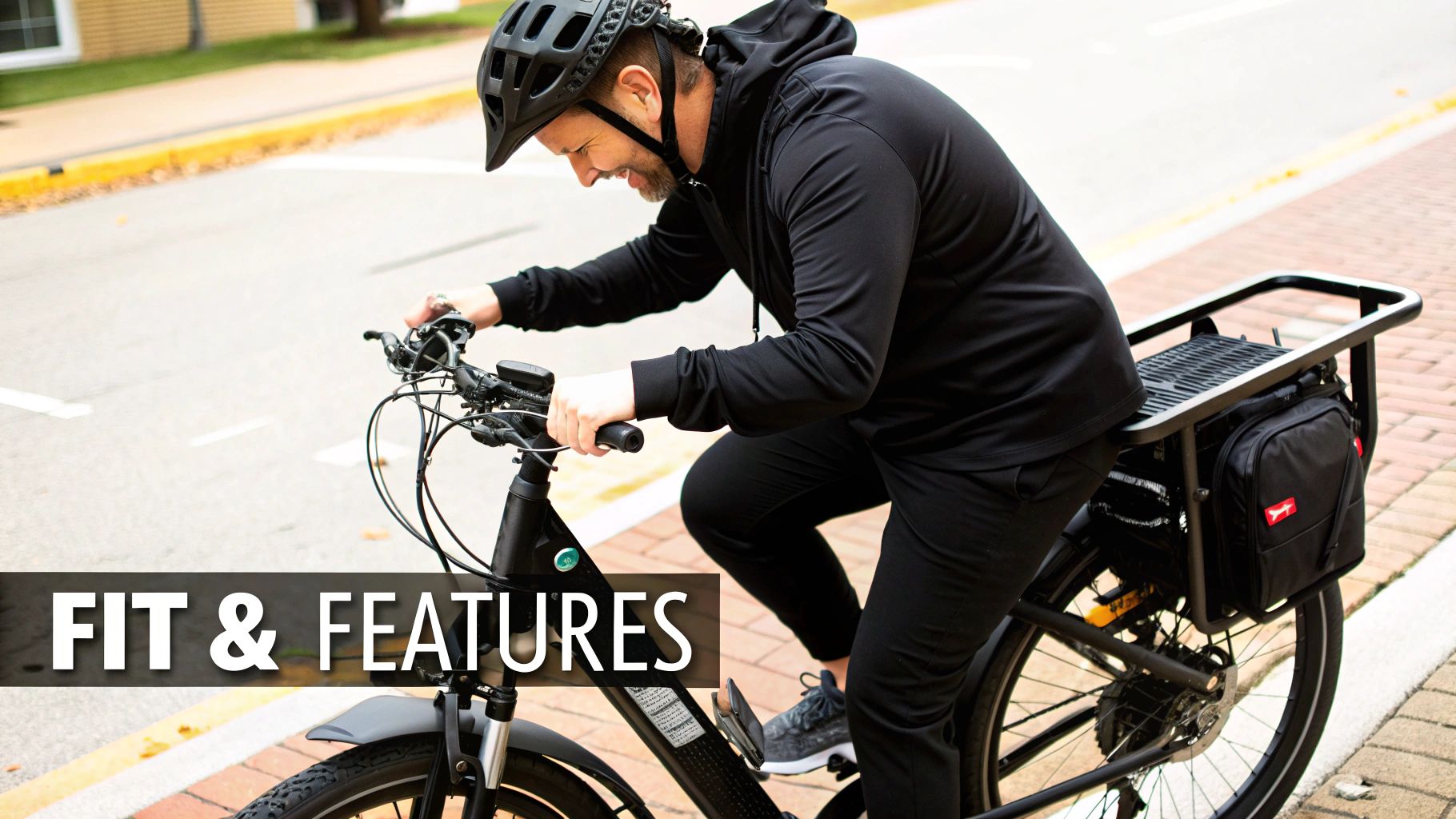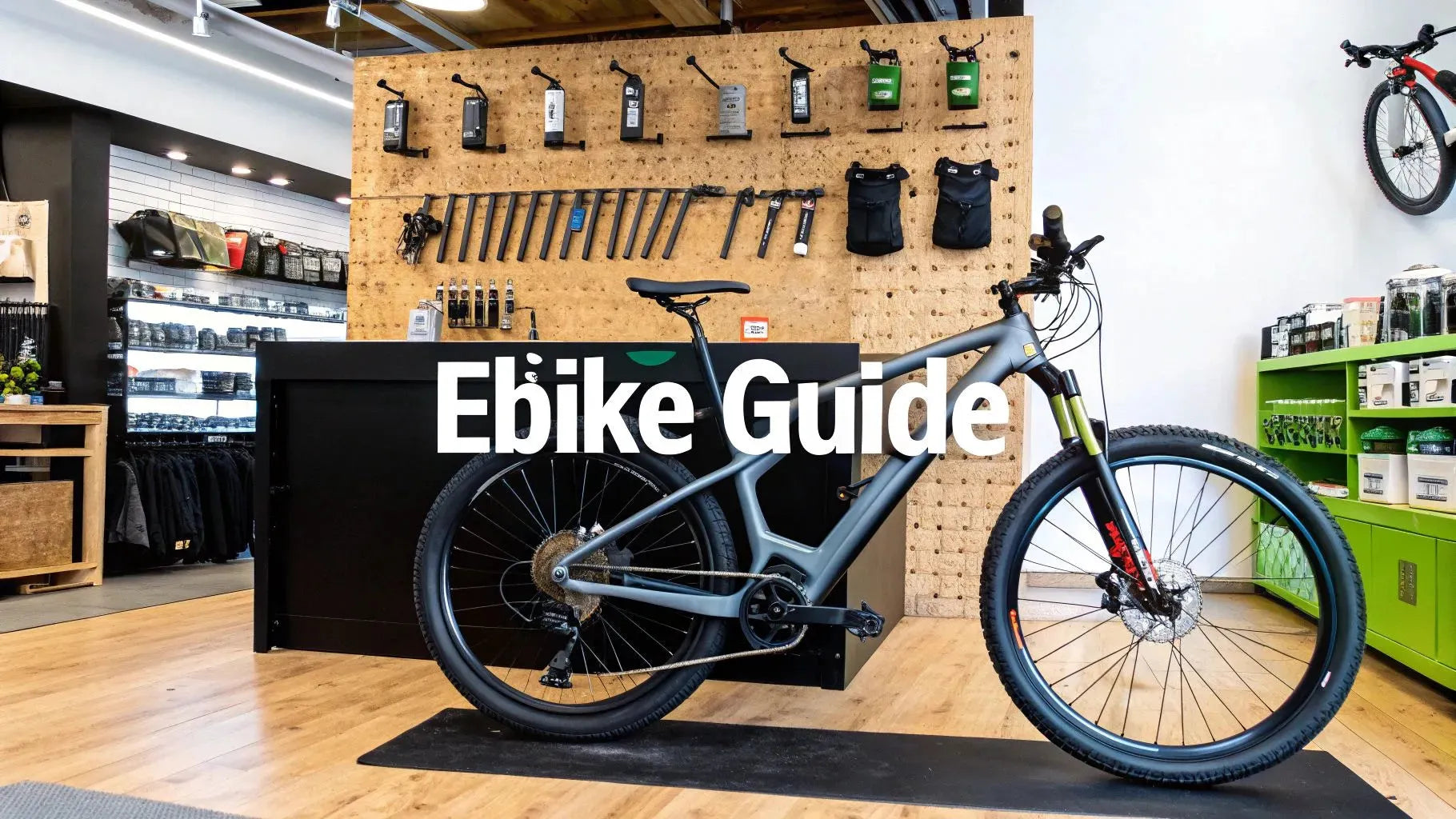So, you're thinking about getting an e-bike? Awesome. But with all the different models, tech jargon, and price points out there, it's easy to feel a little lost.
Don't worry, you've come to the right place. Think of this as a conversation with a friend who’s been through it all and can help you skip the confusing parts. We're not here to find the "best" e-bike ever made; we're here to find the absolute best e-bike for you.
The Three Questions That Matter Most
Before we get into motor specs or battery capacity, let's dial it back. Picking the right bike really just boils down to being honest about three things:
- Why are you riding? Are you trying to ditch your car for the daily commute? Maybe you're looking for a beast to tear up some trails on the weekend. Or perhaps you just want a comfy, easy way to cruise around town and run errands.
- Where are you riding? Your terrain makes a huge difference. Think about it—navigating the flat, smooth bike lanes of a city is a world away from grinding up the steep, winding hills of the countryside.
- What’s your budget? Knowing what you're comfortable spending right from the start saves a ton of time. It lets you focus on the bikes that give you the best bang for your buck.
Honestly, figuring out your main reason for riding is the most crucial step. A heavy-duty mountain e-bike would be a drag on a daily commute, just like a simple city cruiser would get eaten alive on a rocky trail.
There's a reason the e-bike market is exploding—it was valued at around $54.1 billion recently. People are catching on to how great they are for both getting to work and just having fun. In fact, a whopping 86.07% of the market is for personal use, which just goes to show how many people are buying them to make their daily lives better. You can discover more insights about the growing ebike market and see where things are headed.
This handy visual below really breaks down how your answers to those three questions point you toward the right kind of bike.

As you can see, once you know your purpose, terrain, and budget, it’s like having a filter. It instantly gets rid of the wrong choices and shines a spotlight on the bikes that will actually fit your life.
Quick Ebike Matchmaker
Feeling overwhelmed? This table should help you narrow things down at a glance. Just find your main goal to see which e-bike type is likely your best bet.
| Your Main Goal | Best Ebike Type | Key Feature to Look For |
|---|---|---|
| Daily Commuting | Commuter / Hybrid | Built-in racks, fenders, and lights |
| Off-Road Adventures | Electric Mountain Bike (eMTB) | Full suspension and a powerful mid-drive motor |
| Leisurely Rides | Cruiser | Comfortable upright seating and a step-through frame |
| Saving Space | Folding Ebike | Compact frame and small wheels for portability |
| Hauling Kids or Groceries | Cargo Ebike | Extended frame with a large, sturdy rack |
Remember, this is just a starting point. Your perfect bike is out there, and figuring out what you truly need is the first—and most important—step to finding it.
What Kind of Rider Are You?
Honestly, the most powerful motor or the biggest battery doesn't mean a thing if the e-bike doesn't actually fit into your life. Before you start getting mesmerized by specs and tech, the very first thing to do is figure out what kind of rider you really are. It’s all about matching the bike to your world, not just chasing impressive numbers on a website.
Take a second and think about your typical week. Are you weaving through city traffic on your way to work? Getting muddy on trails over the weekend? Or are you the type who just wants a chill ride to the farmer's market? Each of these missions calls for a completely different kind of e-bike.
The Urban Commuter
For anyone doing the daily grind through busy streets like those in London or Berlin, it's all about being quick and nimble. Your ride isn't a lazy Sunday cruise; it's a mission to get from Point A to Point B without showing up to work a sweaty mess.
You're probably dodging traffic, navigating bike lanes, and carrying your life in a bag—laptop, change of clothes, you name it. Your e-bike needs to be a totally reliable workhorse.
If you're a city rider, here’s what to zero in on:
- Agility: A lightweight frame and responsive handling are your best friends for squeezing through tight spots and reacting to a car door opening unexpectedly.
- Practicality: Don't think of integrated mudguards, lights, and a pannier rack as optional extras. They're non-negotiable for commuting in all seasons and all weather.
- Security: Little things can make a big difference. A removable battery is a huge win, letting you charge it up at your desk while your bike is safely locked up outside.
I see this all the time: city riders buying a super heavy, overpowered e-bike. For most urban commutes, a zippy hybrid or even a compact folding e-bike will serve you a million times better than a bulky electric mountain bike.
The Weekend Adventurer
If your perfect day involves ditching the pavement for rugged Welsh trails or scenic forest paths, you're an adventurer. Your rides are about exploring and getting that rush of adrenaline, which means your e-bike needs to be tough, capable, and ready for whatever the trail throws at it.
You're not looking for flat, easy paths—you're actively seeking out gnarly hills and tricky terrain. For you, it's all about power and durability.
Here’s what adventurers should have on their checklist:
- Powerful Motor: A mid-drive motor is usually the way to go. It delivers better torque, which is an absolute game-changer when you're trying to claw your way up steep, loose climbs.
- Robust Suspension: Front suspension is the bare minimum, but if you're serious about off-roading, a full-suspension e-mountain bike (eMTB) provides incredible comfort and control on rough tracks.
- Durable Tires: You need wide, knobby tires that can really bite into loose surfaces like dirt and gravel. They give you the stability you need when things get sketchy.
It's also super important to understand the different legal classifications, especially for trail riding. To get up to speed on the most common type you'll find, check out our detailed guide on what is a class 1 ebike. This will help you know what’s allowed on different trail networks so you don't run into any trouble.
The Relaxed Cruiser and Errand Runner
Maybe high-speed commutes and epic trail adventures just aren't your thing. You're picturing yourself on a gentle ride along the canals of Amsterdam, popping over to the local shop, or just enjoying a sunny afternoon in the park. For you, comfort and simplicity are everything.
Your main goal is to simply enjoy the ride itself. You want a bike that’s a breeze to get on and off, dead simple to operate, and just plain fun.
Key features for the cruiser lifestyle include:
- Upright Riding Position: This posture is way easier on your back and gives you a fantastic view of your surroundings. Look for bikes with swept-back handlebars.
- Step-Through Frame: Not having to swing your leg over a high bar makes hopping on and off for errands totally effortless. It’s a small detail that makes a huge difference.
- Cargo Capacity: A front basket or a sturdy rear rack is perfect for hauling groceries, a picnic blanket, or whatever you picked up while you were out and about.
By being honest about how you'll really use your e-bike, you can build a mental checklist. This simple bit of self-reflection helps you walk right past the bikes that look cool but are totally wrong for you, and instead focus on the ones that will actually put a smile on your face every time you ride.
Understanding Motors and Batteries
Let's get into the heart of what makes an e-bike tick: the motor and the battery. You don't need an engineering degree to understand this stuff. Think of them as the engine and the fuel tank of your ride—they're what determine how the bike feels, how it tackles hills, and how far you can actually go.
Getting a handle on these two things is the secret to finding a bike that truly fits your needs.

The motor is what provides that almost magical boost, turning a dreaded climb into a surprisingly pleasant spin. When you start comparing bikes, you'll see two main types of motors pop up again and again, and they each have their own personality.
The Great Motor Debate: Hub Drive vs. Mid Drive
First up is the hub-drive motor. You'll find this one tucked away inside the hub of the rear wheel (and occasionally the front). A hub motor feels like it's giving you a solid, steady push from behind. It's a straightforward, reliable, and more affordable system, which is why you see it on so many city commuters and casual cruisers.
If your rides are mostly on flat city streets, say, cruising around Manchester or Amsterdam, a hub motor is probably all the boost you'll ever need to make getting around a joy.
Then you have the mid-drive motor. As the name suggests, this one is located right in the middle of the bike, down by the pedals. This central placement is a huge win for balance and performance. A mid-drive motor feels less like you're being pushed and more like your own pedalling power is being supercharged.
This design really comes alive on hilly terrain. If you're planning to conquer the steep streets of Edinburgh or dreaming of a cycling adventure in the Alps, the extra torque and efficiency of a mid-drive will make a massive difference.
Here’s a simple way to think about it: a hub drive pushes the bike, while a mid-drive assists your pedalling. Because it’s connected directly to the bike's gears, a mid-drive works more efficiently, especially on tough climbs, giving you a much more natural and responsive ride.
Demystifying Power and Torque
You're going to see words like "watts" and "torque" on every spec sheet. So what do they actually mean for how the bike feels?
Watts (W) tell you the motor's power output. In the UK and EU, road-legal e-bikes are capped at 250W of continuous power.
Torque, on the other hand, is the twisting force the motor produces, and it's measured in Newton-metres (Nm). This is the oomph you feel when you pull away from a standstill or hit a steep hill. A higher torque number (like 85Nm versus 50Nm) means the bike will feel way punchier and more capable on inclines.
Let's break down how these two motor types compare head-to-head.
Hub Drive vs. Mid-Drive Motors
Choosing between a hub and a mid-drive motor is one of the biggest decisions you'll make. It really comes down to your budget and the kind of terrain you'll be riding on. This table should help clear things up.
| Feature | Hub Motor | Mid-Drive Motor |
|---|---|---|
| Best For | Flat city commutes, budget-conscious riders | Hilly terrain, off-road, performance riding |
| Feel | A sensation of being pushed | Natural, amplified pedalling feel |
| Efficiency | Generally less efficient, especially on hills | Highly efficient, uses bike's gears |
| Weight Distribution | Weight is on the rear or front wheel | Central and low, improving balance |
| Price | Typically more affordable | Often found on more premium bikes |
The huge boom in the e-bike industry is thanks in large part to how good these motors have become. The choice between a more affordable hub motor and a high-performance mid-drive is a key factor for buyers, with the global e-bike motor market projected to jump from $12.79 billion in 2025 to $33.41 billion by 2032. It's a massive market, and you can read the full research about the e-bike motor market if you want to geek out on the trends.
Understanding Your Fuel Tank: The Battery
If the motor is the engine, the battery is your fuel tank. Its capacity is the single biggest thing that dictates how far you can ride on one charge. The number you need to pay attention to is Watt-hours (Wh).
It's simple: a bigger Wh number means a bigger "fuel tank," which means more miles before you need to plug in. A standard commuter e-bike might have a 400-500Wh battery. A long-range touring bike or an e-mountain bike? You could be looking at 625Wh or even more.
But don't take the manufacturer's claimed range as fact. Your real-world range depends on a bunch of factors:
- Terrain: Hills are a battery killer. You'll burn through a charge way faster than you will on flat ground.
- Assist Level: Riding in "Turbo" all day will drain your battery much faster than sticking to "Eco" mode.
- Rider Weight: It takes more energy to move more weight.
- Wind and Tyres: Fighting a headwind or riding on under-inflated tyres creates drag and uses up more juice.
A 500Wh battery might get you 50 miles on a flat path with low assist, but that could easily drop to 25 miles if you're tackling steep hills on the highest power setting.
Taking good care of your battery is also key to making it last. To get the most out of every single charge, it pays to learn how long ebike batteries last and how to care for them. Once you get a feel for these core components, you'll be able to look at a spec sheet and know exactly what you’re getting, ensuring you pick an e-bike with the power and range to match your adventures.
Finding the Right Fit and Features

A beefy motor and a long-range battery are great on paper, but they mean very little if riding your e-bike is a pain. Honestly, the real magic that makes you fall in love with your bike is in the fit and features—the stuff that directly impacts how comfortable and safe you feel.
This is where we stop talking about the engine and start focusing on the cockpit. Getting these details right is the difference between an e-bike that feels like an extension of you and one that just feels like a machine you're wrestling with.
Frame Style and Your Comfort Zone
Your first and most important point of contact with the bike is its frame. The style you pick has a huge effect on how easy and pleasant it is to use every day, especially if you're weaving through city streets or just popping out for groceries.
You'll mainly come across two styles:
- Step-Through Frames: These are a game-changer for urban riding. With no high bar to swing a leg over, hopping on and off is a breeze. That’s a massive plus in stop-and-go traffic or when you're just wearing normal clothes.
- Traditional Frames (Diamond or Crossbar): This classic design is stiffer and more rigid, which is why you see it on hybrid and mountain e-bikes that take a bit more punishment. They usually put you in a more forward-leaning, engaged riding position.
For most daily commuters and casual riders, the sheer convenience of a step-through frame makes it the clear winner for practical, everyday use.
A classic mistake is getting so wowed by a powerful motor that you forget about the frame. You're going to be getting on and off that frame every single time you ride. A bike that’s comfortable and easy to mount will get used way more than one that feels awkward.
The Components That Really Matter
Beyond the frame, a few key parts can make or break your entire riding experience. It’s easy to get bogged down in tech specs, but for those of us riding in the UK and Europe, some features are non-negotiable for staying safe and actually enjoying the ride.
Brakes: Why You Need Hydraulic Discs
Picture this: you're navigating a rainy London street or flying down a steep hill somewhere in Europe. You need brakes you can absolutely count on. This is where hydraulic disc brakes come in—they're the gold standard for a reason. They give you serious, consistent stopping power in any weather, rain or shine.
You might find mechanical disc brakes or even rim brakes on cheaper models, but the extra safety and reliability of a hydraulic system is worth every penny. They take less effort to pull and give you so much more control right when you need it most.
Suspension: Is It a Necessity?
Do you really need suspension for UK roads? If your commute involves cobbled streets, cracked pavement, or bumpy cycle lanes, the answer is a resounding yes. Even a basic front suspension fork can soak up the worst of the bumps and vibrations, saving your hands and wrists from a lot of grief.
Full suspension is usually overkill unless you're a serious off-road e-mountain biker. For most of us on city streets and hybrid trails, front suspension hits that sweet spot between comfort and efficiency, smoothing out the rough patches we all deal with.
Sorting the Must-Haves from the Nice-to-Haves
As you narrow down your choices, it helps to split features into two camps: essentials and extras. What's essential for a year-round commuter in Manchester might be an optional luxury for a fair-weather rider on the south coast.
For a reliable, all-season commuter bike in the UK or EU, I'd say these are must-haves:
- Integrated Lights: Lights that are wired directly to the main battery mean you never have to worry about charging them or someone pinching them. They're vital for being seen and staying safe.
- Full-Length Mudguards: These are non-negotiable. They keep road spray and muck off your clothes, which is a lifesaver during a wet European winter.
- Pannier Rack: A solid rear rack is what turns your e-bike into a proper utility vehicle. It’s essential for carrying everything from your laptop to a week's shopping.
At the end of the day, the best features are the ones that remove friction and make you want to get out and ride. While some e-bikes are built for pure performance with parts like those found on the best mid drive electric bike, others are all about practical, day-to-day usability. Making sure your bike is comfy, safe, and kitted out for your journey is the final piece of the puzzle.
Setting Your Budget and Where to Buy

Alright, let's talk about the big one: money. How much should you actually plan to spend on an e-bike, and where’s the best place to hand over your hard-earned cash? The price tags can be all over the place, from a few hundred quid to what you'd pay for a decent used car.
Breaking it down into price brackets is the easiest way to get a handle on what you’re really paying for. It helps you set realistic expectations for quality, performance, and how long the bike is likely to last.
What Your Money Buys You
The price of an e-bike is almost always a reflection of its components—especially the motor, battery, and brakes. Here’s a rough idea of what to expect as you move up the price ladder.
The Entry-Level Zone (Under £1,500 / €1,700)
Bikes in this range are great for casual riders or short, mostly flat commutes. They get the job done without breaking the bank.
- What you'll get: A solid hub motor, a battery that’s good for local trips, and mechanical disc brakes.
- What to watch for: Heavy steel frames and generic electrical parts. My advice? Stick to known brands to avoid headaches down the line with safety and reliability.
The Sweet Spot (£1,500 - £3,000 / €1,700 - €3,500)
For most people, this is the magic number. You get a serious upgrade in quality and performance that you'll notice every single time you ride.
- What you'll get: Lighter aluminium frames, brand-name motors from the likes of Bosch, Shimano, or Brose, bigger batteries (500Wh+), and much more responsive hydraulic disc brakes.
- What to look for: Bikes that come kitted out with integrated lights, mudguards, and a sturdy pannier rack.
The Premium Tier (£3,000+ / €3,500+)
Welcome to the high end. You're paying for peak performance, feather-light materials, and the latest tech. These are built for serious commuters, long-distance adventurers, or e-mountain bikers who demand the best.
- What you'll get: Powerful mid-drive motors with tons of torque, long-range batteries (625Wh+), top-of-the-line suspension, and lightweight carbon bits and pieces.
The e-bike market has absolutely exploded. It's jumped from around $36.4 billion and is on track to hit $121.4 billion by 2034. Europe is leading the charge, pouring money into cycling infrastructure. This makes buying a quality e-bike a smarter long-term investment than ever. You can dive deeper into the booming global ebike market on market.us.
Local Bike Shop vs. Online Retailer
Once you've got a budget in mind, the next decision is where to buy from. It's a classic dilemma for buyers across the UK and EU, and honestly, there are good arguments for both.
Making the Case for Your Local Bike Shop
You just can't beat hands-on expertise. A good local shop lets you test ride different models, which is huge for getting a feel for the bike and making sure it fits you properly. You can't do that clicking a mouse.
- The good: You get expert advice, professional assembly (a big plus!), test rides, and ongoing support for servicing and repairs.
- The not-so-good: Prices are often a bit higher, and their selection might be more limited than what you'll find online.
The Pull of Buying Online
Direct-to-consumer brands can offer incredible value. By cutting out the bike shop, they can often pack better components onto a bike for the same price.
- The good: You'll find very competitive pricing, a massive selection, and the pure convenience of having it delivered to your door.
- The not-so-good: No test rides. You'll probably have to do some of the final assembly yourself, and sometimes, finding a local mechanic who's happy to work on a brand they don't sell can be a challenge.
A Few Smart Ways to Save Some Cash
A good e-bike is a real investment, but there are ways to make it more affordable without skimping on quality. If you're in the UK, the absolute best way is the Cycle to Work scheme.
This government programme lets you get an e-bike through your employer, and you pay for it out of your pre-tax salary. This can easily save you 25% to 42% on the total cost. It’s a brilliant way to make a higher-end, more dependable bike much more affordable. Many EU countries have similar tax incentives, so definitely check to see what’s available where you live. How you buy your bike is almost as important as which bike you buy.
Common Ebike Questions Answered
As you zero in on the perfect e-bike, a few practical questions always seem to pop up. It's totally normal. Getting these details straight is the last step before you can ride off with total confidence. We've pulled together the most common things people ask us to give you clear, no-nonsense answers.
How Far Can I Really Go on One Charge?
Think of the range listed on a bike's website like a car's MPG sticker—it’s based on perfect, lab-like conditions. Your real-world mileage will absolutely vary.
So, what affects it? A whole bunch of things. Your weight, how hilly your route is, if you're riding into a headwind, and even your tire pressure all have an impact. But the biggest factor, by far, is how much you rely on that electric boost. Cranking it up to "Turbo" to flatten hills will chew through your battery way faster than cruising in "Eco" on a flat bike path.
Let's put that into perspective. A standard 500Wh battery might get you a solid 40 miles on a gentle ride along a canal path. But that same battery might only last for 20 miles if you’re tackling steep hills with the power on full blast. You’ll quickly get a feel for it, learning when to push the motor and when to save the juice.
What Are the Ebike Laws in the UK and EU?
Thankfully, staying on the right side of the law is pretty simple. In both the UK and the EU, your e-bike is legally treated just like a regular bicycle. That means no license, no registration, and no insurance required.
This all holds true as long as your bike ticks a few key boxes:
- The motor's power output can't exceed 250 watts.
- The electric assist has to cut out once you hit 15.5 mph (25 km/h).
- The motor should only kick in when you're actually pedaling (this is what's known as a 'pedelec').
Any bike with a throttle that lets it move without pedaling, or one that assists you past that 15.5 mph limit, usually gets classified as a moped. That puts it in a whole different category with its own rules, including needing a license and insurance. We strongly advise against "derestricting" a standard e-bike—it’ll likely void your warranty and could land you in legal trouble.
How Much Maintenance Does an Ebike Need?
Here’s some good news: an e-bike isn't much more work to look after than a non-electric bike. All the core bicycle parts—tires, brakes, chain—need the same basic love and attention you’d expect. You'll still need to keep the tires pumped up, check your brake pads for wear, and keep that chain clean and lubed.
The electrical bits, like the motor and controller, are usually sealed units designed to be almost maintenance-free. The one component that needs a little thought is the battery.
To get the longest possible life out of your battery, try to keep it out of extreme hot or cold temperatures. And whatever you do, don't store it completely dead for a long time. A bit of care goes a long way in keeping it healthy for years to come.
Getting your e-bike serviced by a pro once a year is also a great move. A good mechanic can check for motor software updates and make sure all the electrical connections are solid, keeping your ride running smoothly and safely.
Should I Be Worried About Theft?
Unfortunately, yes. E-bikes are valuable, and that makes them a prime target for thieves. You really need to make security a top priority from day one. Investing in a great lock isn't just a recommendation; it's essential.
Look for a lock with a Sold Secure Gold rating. Your best bet is a heavy-duty D-lock or a thick, chunky chain. Always lock your bike’s frame to something solid and immovable, like a proper bike rack or a lamppost. If your lock is long enough, it's always a good idea to loop it through a wheel, too.
For an extra layer of security, especially if you're in a big city like London or Paris, you might want to consider specific e-bike insurance or even a hidden GPS tracker. Taking these extra steps can save you a world of heartache and help you get your bike back if the worst happens.
At Punk Ride LLC, we’re here to help you find the perfect ride that matches your style and needs. Our curated selection of top-tier electric bikes and scooters from leading brands ensures you get the best in performance and reliability. Explore our collection and start your next urban adventure today at https://www.punkride.com.





Share:
How to Choose an Electric Scooter: A Practical Guide
Your Guide to repair scooter tire: Pro Tips